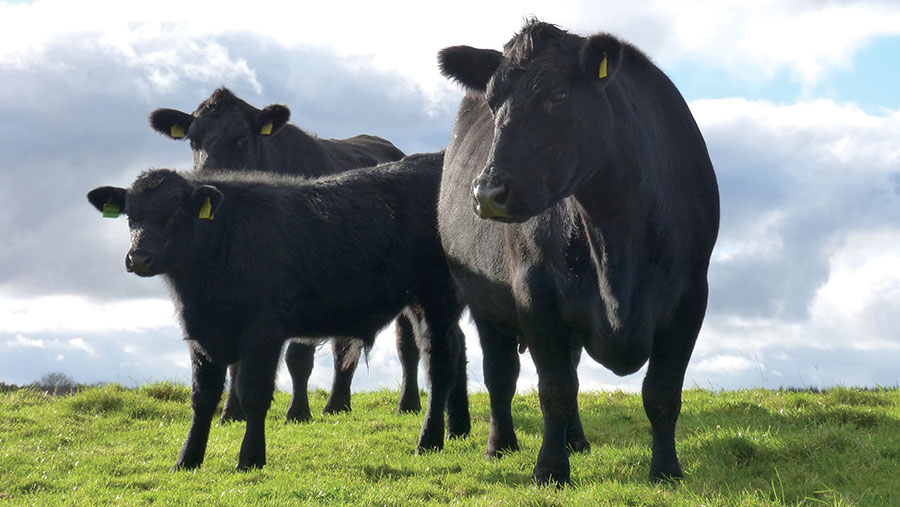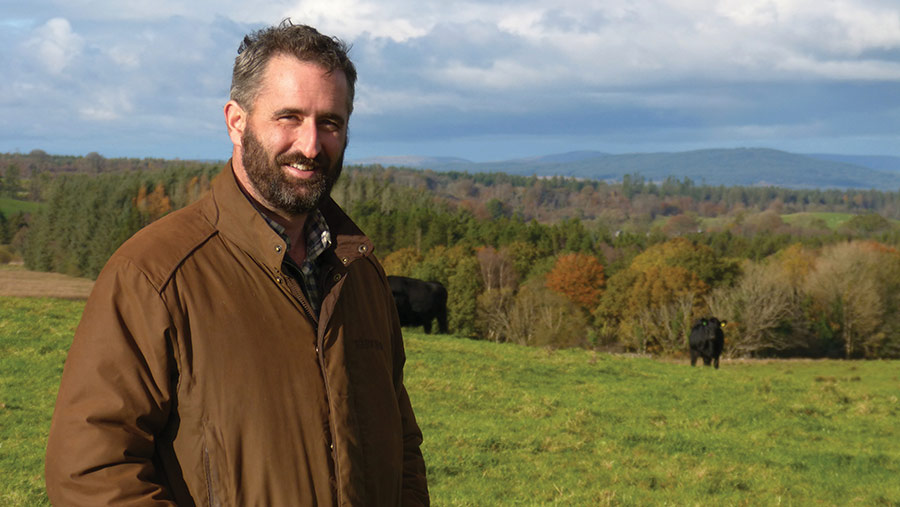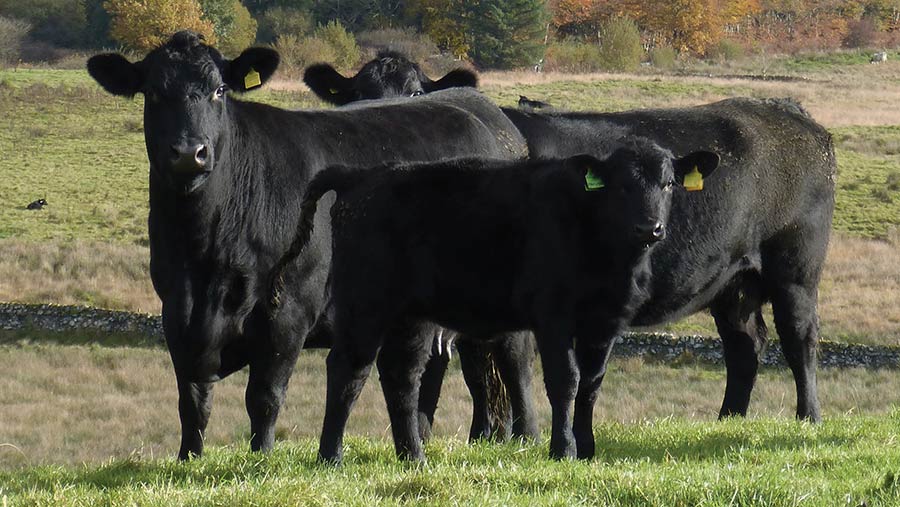How suckler unit trebled and added pedigree Angus herd
 © MAG/Michael Priestley
© MAG/Michael Priestley Harnessing fertile, easy-calving suckler cow genetics and having an open mind about working with others have helped a suckler farmer treble stock numbers and add a pedigree enterprise to his business.
William Moses farms rocky soils, undulating clay-capped drumlins and mossy, peaty bogs near Newton Stewart, in Dumfries and Galloway. It is a good testing ground for functional suckler cow genetics.
See also: Hereford herd grows demand with line-bred US genetics
He transformed an 80-head Limousin-cross suckler herd, calving year round, into a 200-head Black Baldy herd calving in nine weeks, after returning home with an Aberdeen University agriculture and business management degree.
With shed space for only 40, William had to focus on breeding cattle that could outwinter and calve outdoors, and look for contract wintering ground for youngstock.
He now runs 400 livestock units himself, with the help of contractors to shear, silage, reseed and winter 200 head of cattle on bed-and-breakfast arrangements.

William Moses © MAG/Michael Priestley.
Farm facts
Challoch Farm, Newton Stewart, Wigtownshire
- 120ha effective – all in-bye
- Mix of improved grassland and permanent pasture
- 80ha of rush, bog and floodplain
- Scotland’s Rural College High Health Scheme
- Sells 350-400kg cattle at Newton Stewart
Oakburn
- 100ha low-input grassland and moss
- Very similar ground to Challoch
- Housing for 90 head
High Eldrig
- Wigtownshire moss hill up to 250m
- Produces prime lambs for Newton Stewart Market
- Site of special scientific interest and special area of conservation
Expansion
The Moses family first came to Challoch from Northern Ireland in the 1970s. William’s grandfather, David, father, Laren, and uncle, Joseph, bred Herefords.
The first thing William did when he returned home in 2008 was to buy an Angus bull to run with the herd year round while he got used to managing the farm.
Several opportunities allowed him to increase from 80 cows and 300 ewes to a larger-scale operation.
- 2014 An agreement to rent High Eldrig (six miles from Challoch) was signed. This is an extensive blanket bog and rough hill with 700 hefted ewes. About 14ha (35 acres) is walled and there is a sheep fank (pen) with a race.
- 2015 Securing hill ground for an expanded sheep enterprise allowed the cows to double to 160 head and gave William impetus to look at wintering options for cattle. He found a range of bed-and-breakfast cattle options to retain stock to continue selling 400kg cattle that had been cheaply wintered on silage. This is now done locally, but initially saw cattle taken as far away as north Ayrshire and Annan.
- 2020 Joseph retired, offering a rental agreement next door, creating a 303ha (750-acre) grassland farm at Challoch.

© MAG/Michael Priestley
Pedigree beginnings
William grew the commercial herd, settling on Angus-cross cows bred locally by Hugh Young, Claunch.
He added hybrid vigour with Herefords from Baldinnie and John Douglas at Ervie Herefords, Stranraer.
This produced cattle that outwintered on forage alone, were fertile and calved outdoors from March to May.
“I can’t see low-cost suckler cows working without fertility being there first,” he explains. “I have selected for length of frame and fertility, and purposefully avoided myostatin.”
At the same time, he researched elite pedigree Angus herds. In 2017, the desire to breed his own bulls came to the fore when four bulls were needed to meet growing cow numbers and replace bulls injured on the hilly terrain.
He registered the Challoch Angus prefix the next year and bought two Liley cows bred from Rawburn Duchess and some maiden Wedderlie heifers.
Cattle at the Weeton dispersal in 2020 and the Blelack dispersal in 2021 completed the core of the herd.
Multiplying elite genetics
William has used in-vitro embryo production (IVP) and embryo transfer to maximise genetic gain on this investment.
The “coasting” technique has been used for greater oocyte quality and numbers, requiring six hormone injections before collection.
Five females underwent IVP, as this method is non-surgical, generates a larger number of offspring than multiple ovulation embryo transfer (Moet) and is more flexible in terms of bull use because of the frequency of collection.
Programming the donor costs about £70, compared with Moet, which is more than double that price.
William says opting to freeze the embryos gave him the flexibility of implanting embryos the following summer to ensure a spring calving. Recipients are synchronised between baling and shearing.
“IVP requires less semen per fertilisation, so one straw can fertilise multiple donors.
“We have used Blelack Duke – which is in the top 5% for eye muscle area – and Blelack Lord Heartford – which is in the top 5% for 200-, 400- and 600-day growth – over Challoch oocytes.”
The process worked as follows:
- Flush selection Blelack Princess Charlotte R477, Liley Duchess Millhouse T263 and Blelack Princess U924 were used in 2022. Weeton Miss Annie N373 and Blelack Lady Blackcap NO88 were used in 2021. Four sets of collections have been done.
- Preparation Donors came off grass into a trailer and went to AB Europe, Westruther, Berwickshire.
- Collection The donors were managed by AB Europe through a livery service, which collected oocytes and fertilised them in the lab.
- Success rate The cows yielded an average of 12 embryos/flush; 70 were frozen using vitrification (dehydrated and frozen).
- Recipients Maiden commercial Black Baldy heifers are kept at Challoch in one social group from spring turnout, and synchronised with controlled internal drug release at grass.
- Implantation AB Europe technicians implanted embryos, with a 70% hold rate.
Future
William is targeting the pedigree and commercial market with sales of bulls and heifers, with high-fertility, docile, high-health crossbred recipients aimed at commercial breeders.
He has sold 10 embryos at Stirling and some aged bulls through Craig Wilson Livestock.
He used one home-bred bull in 2021, three last year and five this summer. Next year, all bulls will be home-bred, barring a Weeton stock bull.
One sire’s figures have improved greatly while being on the farm, and William is investigating putting him into stud.
He hopes to farm full-time long into the future, despite major policy uncertainty in Scotland.
“Capital investments available in England with the Environmental Land Management scheme, various generous direct grassland payments, and the support for moorland grazing of cattle and sheep, currently under consultation with Defra, would perfectly complement how I farm in Scotland.
“However, we have no idea about policy direction, other than rules being imposed on producing calves and calving interval.
“It’s ironic, because cattle in less-favoured areas are the simplest, most cost-effective way to achieve biodiversity net gain at scale.”
